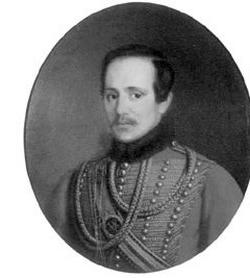The work of M. Yu. Lermontov is a fertile topic for study. Schoolchildren, as a rule, are sincerely interested in the tragic fate of the poet, they are intrigued by the ambiguity, mystery of the personality, carried away by vivid expressive lyrics, and touch loneliness and incomprehensibility even by close people and friends. Mikhail Yuryevich’s poems are easily and with pleasure memorized. Perhaps, only such sharp, social-philosophical works as, for example, the elegy “Duma”, can cause some difficulties in interpretation and understanding.
Introduction to the topic

It is more logical for the teacher or student (on the instructions of the teacher) to make a small introductory report highlighting the socio-historical situation in Russia in the 30-40s. and a preliminary analysis of the poem "Duma." Lermontov - it is worth emphasizing this - was a representative of the advanced part of the nobility. He considered himself and his generation as spiritual heirs and successors of the Decembrists. The tsarist regime tried its best to erase from the memory of the intelligentsia, the people of the events that occurred in 1825. The era of reaction and timelessness, the pursuit of all living thoughts, critical ideas, that is, everything that diverged from the politics of the autocracy, has come. And all those who disagree, the obstinate awaited inevitable retribution, the fate of Pushkin is a vivid example of this. At this point, the teacher should focus the attention of the class, starting the analysis of the poem "Duma." Lermontov and his associates tried to oppose their inner freedom to external bondage, to withdraw into themselves, into their inner world - this was a kind of protest against arbitrariness. However, the attempt was a mistake, an illusion. And the hard work of thought led to complete inaction, inertia. These are the prerequisites for the poet to create his angry elegy in 1838, the theme of which is a critical analysis of his generation and a harsh sentence to him.
Reading by heart and interpretation
The next stage of the lesson is reciting and analyzing the poem “Duma”. Lermontov, according to critic V. G. Belinsky, indicated in him the reasons for his own despondency, emptiness, disbelief in ideals, and the problems of his contemporaries. It is in them that the students, together with the teacher, will have to figure it out. Students are invited to a number of questions: to determine the emotional mood of the work; identify the main lexico-semantic centers of it by indicating keywords; indicate the artistic space of the poetic text. The teacher should try to come to the concept of “reflection”, making an analysis of the poem “Duma” with the class. Lermontov, in fact, introduced a new hero into Russian literature - a reflecting personality: a smart person, thinking, always doubting everything. Introspection, a critical perception of reality and oneself - a hallmark of his and the best part of the noble society. You should pay attention to the
ranks of the pronouns in the poem and conclude: the Poet’s conversation about time and about himself is what the “Duma” is. Lermontov (we continue the analysis) from the personal “I” rises to the generalized “We”, fully sharing the responsibility for idleness, the meaninglessness of his life, emotional and political apathy. He conveys the despair that gripped the noble youth, disbelief in their strengths and capabilities. This emotional plan defines the main poetics of the work.
Paperwork
You can look into the poet’s creative laboratory and find out how the “Duma” is built. Lermontov creates his verse on the model of quatrains. Have the students write the last lines of each. What conclusion does the poet come to? What stylistic and
artistic techniques does he use? What is achieved thanks to them?
The final stage and conclusions
At this point, you should summarize the lesson. Make, write down the necessary conclusions. Help students formulate their points of view on the issues addressed. Reveal the connection with modernity. Show on the example of the lesson the main motives of the lyrics of Lermontov.